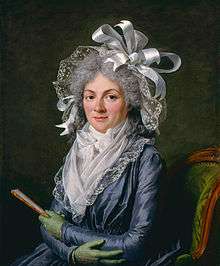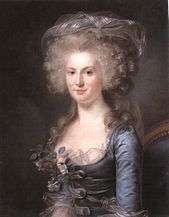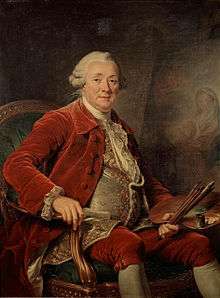Adélaïde Labille-Guiard
| Adélaïde Labille-Guiard | |
|---|---|
|
Self-portrait with two pupils, by Adélaïde Labille-Guiard, 1785. The two pupils are Marie Capet and Carreaux de Rosemond. | |
| Born |
Adélaïde Labille 11 April 1749 Paris, France |
| Died |
23 April 1803 (aged 54) Paris, France |
| Nationality | French |
| Known for | Miniatures, painting, pastels |
| Movement | Rococo to Neoclassicism |
Adélaïde Labille-Guiard (11 April 1749 – 24 April 1803), also known as Adélaïde Labille-Guiard des Vertus, was a French miniaturist and portrait painter.[1][2]
Family

Adélaïde Labille-Guiard was born in Paris, the youngest of eight children, to a bourgeois family. Her father, the haberdasher Claude-Edme Labille, owned a shop named 'A La Toilette' situated in the Rue neuve des Petits Champs in the parish of Saint-Eustache. Jeanne Bécu, the future Madame du Barry, worked in this very shop around the age of eighteen, and would eventually become good friends with Labille-Guiard.
Her older sister, Félicité, whose date of birth is unknown, married the miniaturist Jean Antoine Gros, a notable painting collector, in 1764 in the Saint-Eustache parish of Paris. It is unknown whether Adélaïde kept in touch with Jean Antoine Gros, his second wife, the pastel artist Pierrette Madeleine Cecile Durant, or his son, the famous Napoleonic painter Antoine Jean Gros, following her sister's death in 1768.
Studies

Though Labille-Guiard became a master at miniatures, pastels, and oil paintings, little is known about her training. Much of this lack of information is due to the practices of the time, which dictated that masters (who were predominantly male) should not take on female pupils, as society perceived that they would not be able to follow instruction alongside men.

During adolescence, Labille-Guiard studied miniature painting with the oil painter François-Elie Vincent, a family friend. Vincent's connections made it possible for her early works to be exhibited at the Académie de Saint-Luc. During this apprenticeship, she would meet her future husband, Vincent's son François-André Vincent.
After marrying Louis-Nicolas Guiard in 1769, she apprenticed with the pastel master Quentin de la Tour until de la Tour's marriage in 1774. After the apprenticeship, she exhibited one of her pastels of a magistrate at the Académie de Saint-Luc. She would continue displaying her works at the Académie until it closed in 1776. After that, she would display her works at the Salon de la Correspondance.
Marriages
At the age of twenty, Labille-Guiard married Nicolas Guiard, a clerk with the Receiver General of the Clergy of France. The marriage contract, signed 25 August 1769, acknowledged that Labille-Guiard was a professional painter at the Académie de Saint-Luc.
The couple separated in 1777, and by 27 July 1779, were officially separated. Both kept the property they had had prior to entering marriage, since separation of property already existed under the Old Regime. After Revolutionary legislation permitted, they divorced in 1793, but Labille-Guiard retained the name Guiard, and remains known to the art world as Labille-Guiard. Thereafter, she earned a living by teaching painting.
On 8 June 1799, Labille-Guiard remarried. Her second husband was the painter François-André Vincent, winner of the Prix de Rome in 1768 and a member of the Royal Academy.
The Académie de Saint-Luc and the Salons up to 1782

Labille-Guiard was admitted to the Académie de Saint-Luc in 1769 by François-Elie Vincent when she was twenty years old. Her admission piece, a miniature, has since disappeared, and no descriptions or records of its existence have survived to this day. Through the Académie de Saint-Luc, which was notable for its numerous female members—it had 130 women by 1777—Labille-Guiard was able to practice art professionally.
She first exhibited her art in 1774 at the Académie de Saint-Luc's Salon. After that exhibition, Labille-Guiard's works would often be compared against those of Elisabeth Vigée-Lebrun, one of Labille-Guiard's contemporaries and a fellow member of the Académie de Saint-Luc.

This show was so successful that the Royal Academy took offense, and with the backing of the monarchy, issued an edict in March 1776 abolishing "guilds, brotherhoods, and communities of arts and crafts". The Académie de Saint-Luc closed its doors in 1777.
At that point, Labille-Guiard began to learn oil painting from her childhood friend François-André Vincent so she could apply to the Royal Academy, which required her to present at least one oil painting for admission.
After the closure of the Académie de Saint-Luc, Pahin de la Blanchisserie established the permanent fair, Salon de la Correspondance, in 1779. For a small fee, artists outside the Royal Academy could exhibit their works. One year after its opening in 1781, Labille-Guiard chose to display some of her pastels, including her self-portrait in pastel and oil portraits of her husband and Guillame Voiriot, a teacher at the Royal Academy, which were well received by critics.
Labille-Guiard's talent as an oil painter and pastellist was quickly noticed, and with the help of François-André Vincent, who referred several of his friends in the Royal Academy to her for portraits, including Joseph-Marie Vien, the professor Bachelier, his friend Suvée, and the aforementioned Voiriot, she achieved national recognition and was accepted as a member of the Royal Academy.
- Paris society portraits by Adélaïde Labille-Guiard
-

Helena Massalska
-

Madame Alexis
Acceptance into the Royal Academy of Painting and Sculpture

On 31 May 1783, Labille-Guiard was accepted as a member of the French Académie Royale de Peinture et de Sculpture. Three other women, including Élisabeth-Louise Vigée-Lebrun, were admitted as members on the same day.
The paintings of Labille-Guiard and Vigée-Le Brun were often compared by critics, with Vigée-Le Brun usually receiving more favorable reviews. Labille-Guiard's early masterpiece Self-portrait with two pupils, exhibited at the Paris Salon in 1785, was influenced by Vigée-Le Brun's style. The artwork of Adélaïde Labille-Guiard is now considered of equal or greater value.
.jpg)
Patronage by the aunt of Louis XVI of France, the princess Marie Adélaïde, gained Labille-Guiard a government pension of 1,000 livres and commissions to paint Adélaïde, her sister Victoire-Louise, and Élisabeth, the king's sister. The portrait of Adélaïde, exhibited in 1787, was Labille-Guiard's largest and most ambitious work to that date. In 1788 she was commissioned by the king's brother, the Count of Provence (later Louis XVIII of France), to paint him at the centre of a large historical work, Réception d'un chevalier de Saint-Lazare par Monsieur, Grand maître de l'ordre.
These royal connections made Labille-Guiard politically suspect after the French Revolution of 1789. In 1793 she was ordered to destroy some of her royalist works, including the unfinished commission for the Count of Provence.
She was far from conservative, however. In the early 1790s she campaigned for the Academy to be reopened to women. At the Salon of 1791 she exhibited portraits of members of the National Assembly, including Maximilien Robespierre and Armand, duc d'Aiguillon.
In 1793 she and her first husband, from whom she separated in 1777, were divorced. In 1795 she obtained artist's lodging at the Louvre and a new pension of 2,000 livres. She continued to exhibit portraits at the Salon until 1800. On 8 June 1799, she married her teacher, François-André Vincent, after which she signed some of her paintings "Madame Vincent". She died on 24 April 1803.
Legacy
Among the public collections holding works by Adélaïde Labille-Guiard are the Getty Museum, the Phoenix Art Museum, Harvard University Art Museums, the Honolulu Museum of Art, Kimbell Art Museum (Fort Worth, Texas), the Los Angeles County Museum of Art, the Louvre, the Metropolitan Museum of Art, the National Gallery of Art (Washington, D.C.), the National Museum in Warsaw, the National Museum of Women in the Arts (Washington, D.C.), the Speed Art Museum (Kentucky) and Versailles.
Labille-Guiard is a featured figure on Judy Chicago's installation piece The Dinner Party, being represented in one of the 999 tiles of the Heritage Floor.[3][4]
-

The comedian Tournelle
-

Marie-Gabrielle Capet, study
-

Madame de Genlis, 1780
-

Marie-Gabrielle Capet, 1785
-

Joachim Lebreton, 1795
Notes
- ↑ Auricchio, Laura (2009). Adélaïde Labille-Guiard : artist in the age of revolution. Los Angeles: J. Paul Getty Museum. ISBN 089236954X.
- ↑ Kleiner, Fred S. Gardner's Art through the Ages: The Western Perspective, 14e. Cengage Learning.
- ↑ "Adelaide Labille-Guiard". Elizabeth A. Sackler Center for Feminist Art: The Dinner Party: Heritage Floor: Adélaïde Labille-Guiard. Brooklyn Museum. 2007. Retrieved 13 December 2011.
- ↑ Chicago, 157–158.
Bibliography
- Anne-Marie Passez, Adélaïde Labille-Guiard, Paris, 1973.
- Baetjer, Katharine. "Adélaïde Labille-Guiard (1749–1803)." In « Heilbrunn Timeline of Art History ». New York: The Metropolitan Museum of Art, 2000–. (June 2016)
- Chicago, Judy. The Dinner Party: From Creation to Preservation. London: Merrell (2007). ISBN 1-85894-370-1
- Roger Portalis, « Adélaïde Labille-Guiard », Gazette des Beaux-Arts, Lausanne, 1901, p. 352–367.
- Roger Portalis, Adélaïde Labille-Guiard, Paris, 1902.
- Women and Art, p. 45–48, Portrait of Madame Adélaïde.
- Jean Cailleux, « Portrait of Madame Adélaïde of France, Daughter of Louis XV », Burlington Magazine (vol.3, March 1969), supp.i-vi.
External links
| Wikimedia Commons has media related to Adélaïde Labille-Guiard. |
- Biography of Adélaïde Labille-Guiard from the Société Internationale pour l'Étude des Femmes de l'Ancien Régime
- Neil Jeffares, Dictionary of pastellists before 1800, online edition







